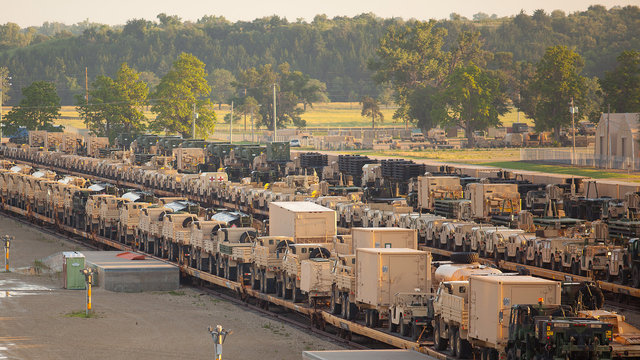
May 3, 2022
What Is a Flatcar Rail Car?
Flatcars hold an important place in railroad history: they were the very first type of rail car used by the railroad industry. Thanks to their simple, flat-deck design, flatcars carried all sorts of freight. For that reason, the design didn’t change much over time. Today, there are several variants of flatcars, including spine cars, centerbeams and well cars. Even so, the basic flatcar is still riding the rails to this day, carrying equipment, machinery, oversized loads, pipe, steel beams and more.

What Are Flatcars Used For?
Flatcars are used to ship freight that is too tall, wide, long or heavy to be shipped on another rail car type. These are referred to as “dimensional loads” or “hi-wide shipments” and include things like heavy construction machinery, military equipment, farm equipment, industrial parts, pipe, steel beams and rails for railroad tracks.
What Does a Flatcar Look Like?
As you might expect, flatcars are…flat. Flatcars consist of a flat, horizontal floor or deck that is mounted on a pair of trucks. Decks may include areas for stakes or tie-down points for securing loads. Flatcars are open to the elements — they do not have sides or a roof like other rail cars.

What Are the Different Flatcar Types?
- Plain Flatcar — Plain flatcars are used to ship things like steel plate, machinery and steel beams. They come in 60- and 89-foot lengths and can carry loads ranging from 147,000 to 202,000 lbs. (73.5 to 101 tons).
- 89-Foot Pipe Flatcar — 89-foot pipe flatcars are used to ship pipe and rail. They can carry loads ranging from 147,000 to 202,000 lbs. (73.5 to 101 tons).
- Specialized Flatcar — Specialized flatcars are used to ship tractors, military vehicles, steel plate and steel beams. They come in 60- and 89-foot lengths and can carry loads ranging from 145,000 to 160,000 lbs. (72.5 to 80 tons). They also feature chain tie down devices that run along the channels on both sides of the car to secure loads.
- Bulkhead Flatcar — Bulkhead flatcars are used to ship steel plate, pipe and wood products. Bulkheads, which are sturdy, vertical walls at each end of the car, help prevent loads from shifting past the ends of the car. Vertical side stakes can also be added to bulkhead flatcars to create lateral protection for freight like pipe. Bulkhead flatcars come in 60- and 62-foot lengths and can carry loads ranging from 142,100 to 210,000 lbs. (71 to 105 tons).
- 89-Foot Log Flatcar — 89-foot log flatcars are used to ship poles and logs. They can carry loads ranging from 180,000 to 194,000 lbs. (90 to 97 tons). Log flatcars are equipped with reinforced permanent steel stakes to make it easier to secure the load.
How Is a Flatcar Loaded and Unloaded?
The way a flatcar is loaded or unloaded depends on the type of freight being shipped. Cranes and forklifts are the most common way to load a flat. Cargo like pipe or rails may be loaded and unloaded with a crane or other mechanical device. Farm equipment, military equipment and heavy construction equipment can be driven on and off of flatcars.

Flatcar Fun Facts
- When trailers ride on flatcars (TOFC) they are referred to as “piggybacks.”
- The use of flatcars to ship trailers took off following World War II; this was referred to as the “piggyback revolution.”
- Union Pacific directly serves more than 25 military facilities and uses flatcars to move military equipment.
- Railroads often use flatcars to haul materials and equipment to maintain tracks, including ties, rail, track panels, work equipment and vehicles.
Learn More
To learn more about flatcars or shipping machinery, military equipment, farm equipment, pipe, steel, poles and other dimensional loads by rail, get in touch.
Want to learn more about other types of rail car equipment, including auto racks, covered hoppers, hoppers, boxcars and gondolas? Check out our rail car type guide.
Related Articles
- Rail Car Types Defined
- What Is a Centerbeam Rail Car?
- Can You Ship Wind Turbines by Train?
- Transportation Modes Revealed: A Comprehensive Look
- The Art of Loading a Rail Car
- Rail: An Environmentally Responsible Way to Ship
- Quiz: Can Your Product Ship by Rail?